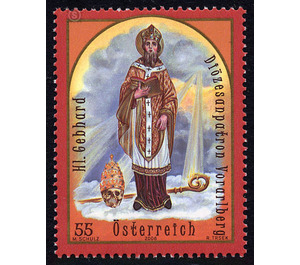patrons - Austria / II. Republic of Austria 2006 - 55 Euro Cent
Theme: Religion & Spirituality
| Country | Austria / II. Republic of Austria |
| Issue Date | 2006 |
| Face Value | 55.00 |
| Edition Issued | 420,000 |
| Printing Type | combination printing |
| Stamp Type | Commemorative |
| Item Type | Stamp |
| Chronological Issue Number | 1949 |
| Chronological Chapter | OOS-OE2 |
| SID | 878792 |
| In 51 Wishlists | |
St. Gebhard was born the son of Count Ulrich IV of Bregenz and the Dietburga of Zähringen in 949. He enjoyed a solid education in the cathedral school of Konstanz and was taught by his uncle, the hl. Conrad I of Constance, ordained priest. At the age of 30 years he received the episcopal ordination and was in 979 under the approval of Emperor Otto II Bishop of Constance. Over and over again entrusted with political tasks by the great ones of the empire, he continued his uncle's reform work and cared for the poor in his diocese all his life. In 983 he donated a monastery in Petershausen near Constance and entrusted Benedictine monks from Einsiedeln with the leadership of the abbey. 992 was the inauguration of the monastery church. The Pope gave the monastery a head relic of Pope Gregory I, to whom the church had been consecrated. Gebhard died on 27 August 995. Soon after his death began his worship as a saint, especially in Vorarlberg. Every year on the Gebhardsberg, where once stood the castle of the Counts of Bregenz, the Bregenz family celebrate its anniversary in the Gebhards church, built in 1793. The hl. Gebhard is second patron saint of Vorarlberg and diocesan patron. He is portrayed as a bishop with staff and church model, holding a skull with a tiara in his hand as an indication of the precious Pope's relic. The representation of St. Gebhard on the altarpiece from the church of Götzis Meschach was chosen for the brand image. The place Meschach is located above the market town Götzis in the mountains. Meschach became famous through Robert Schneider's novel "Schlafes Bruder". In the secluded side valley there was already a chapel in the second half of the 15th century, as can be seen from the year "1463" in the choir of the old church. It is unclear when the church was inaugurated, apparently by the bishop of Luc Lucas Iter in 1548. The church itself was dedicated to St. Wolfgang. The high altar was built by Josef Bertsch in 1883 in neo-gothic style.


